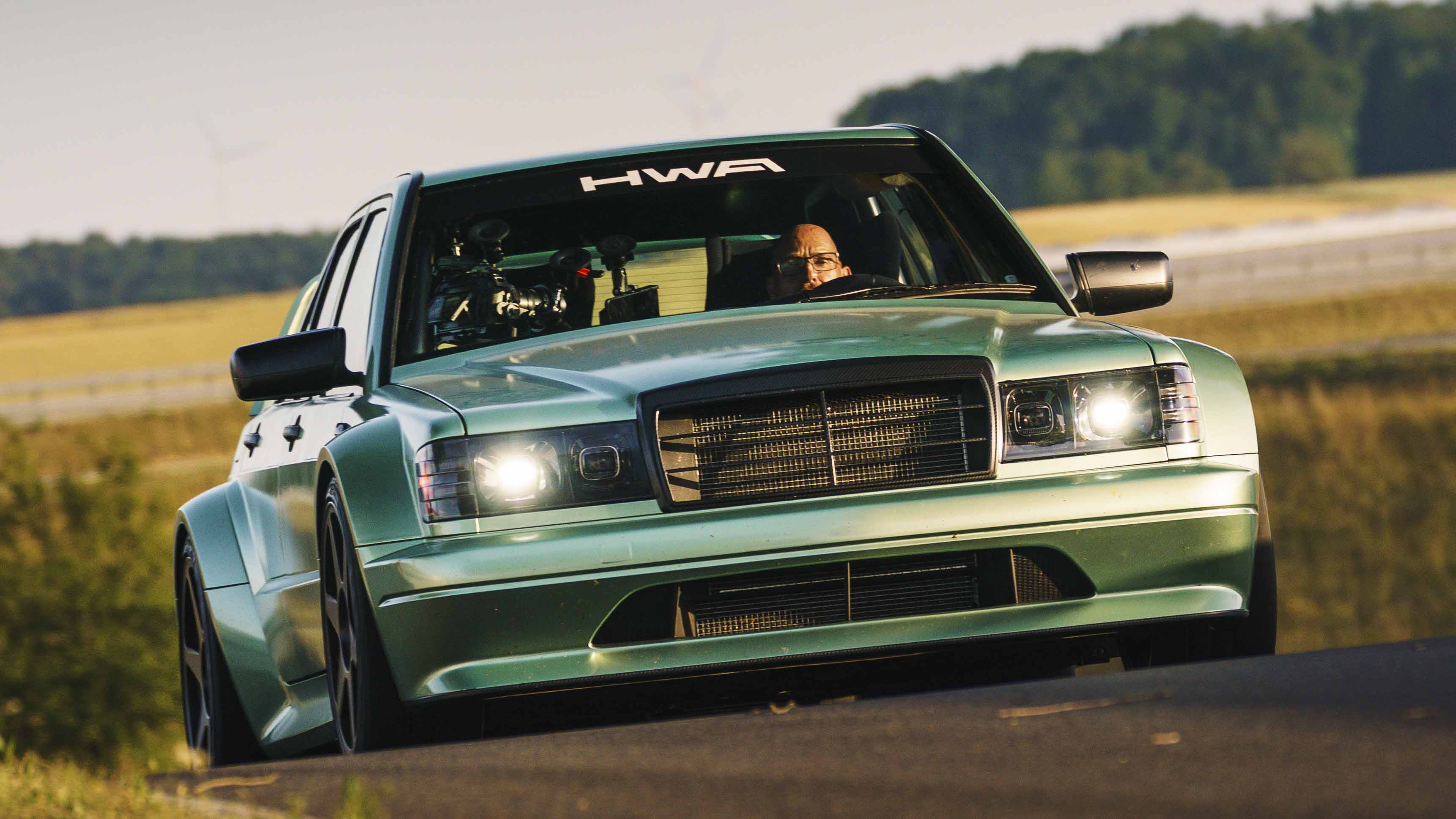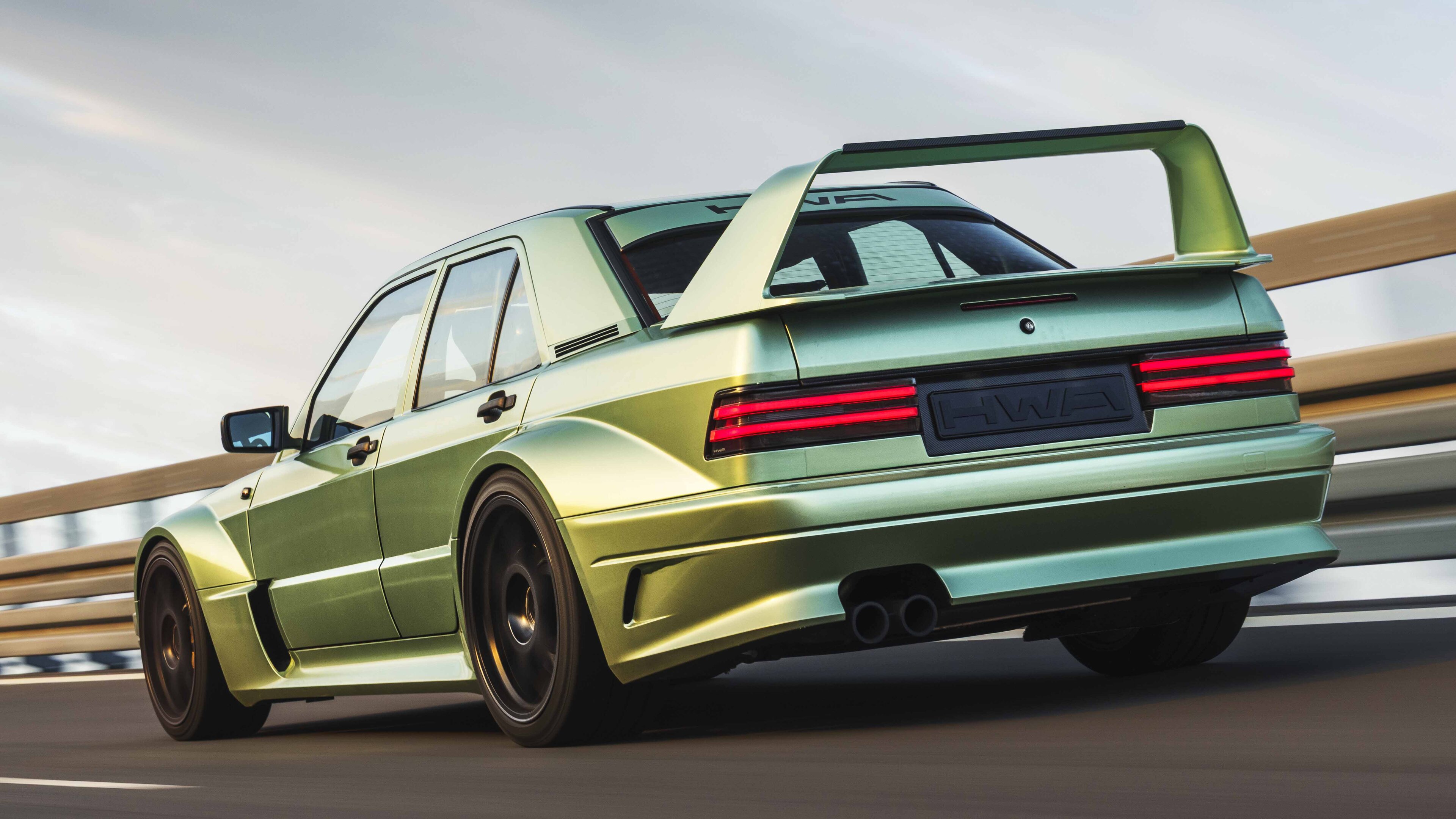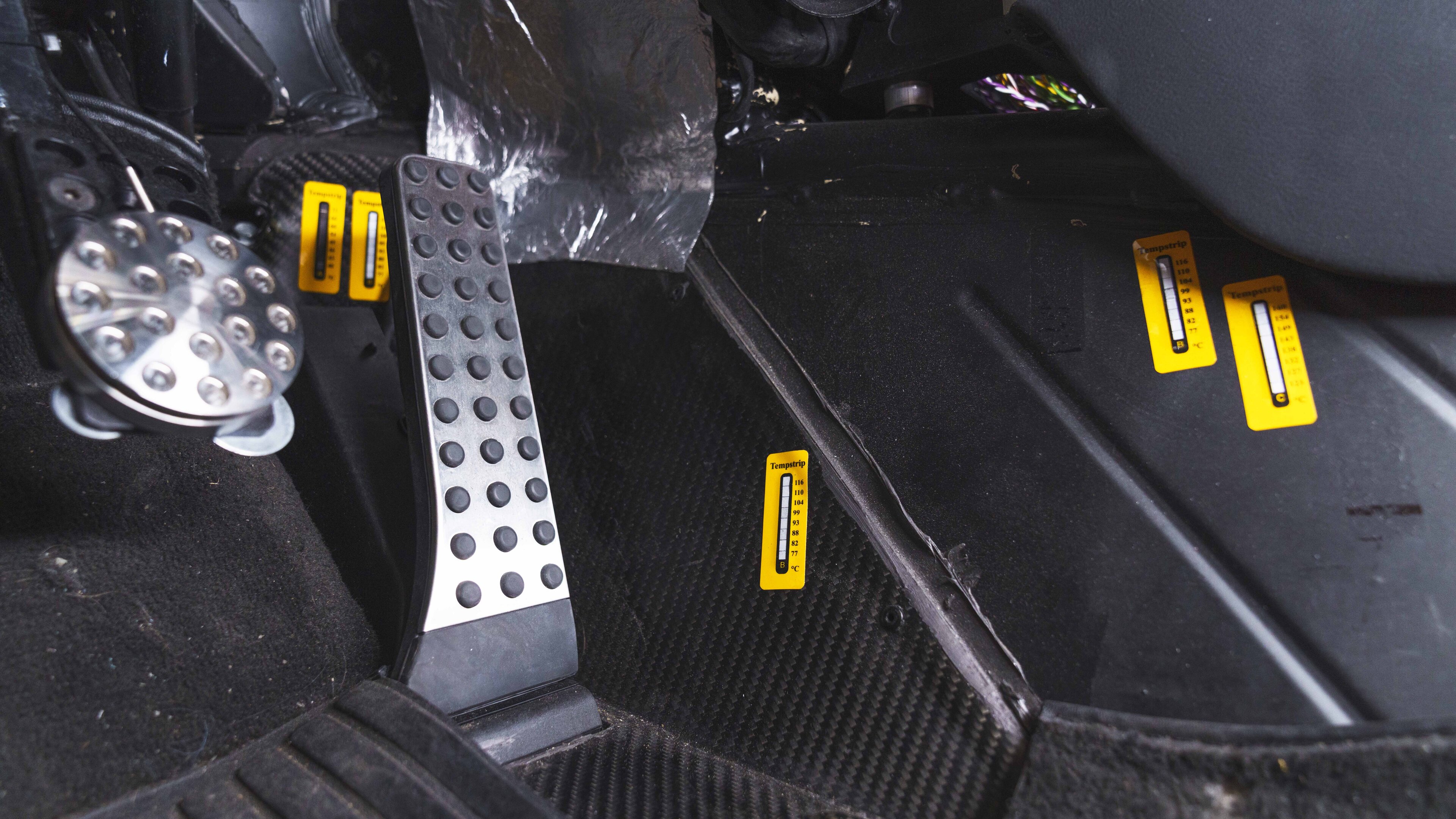
HWA EVO: this V6-engined Merc 190E tribute drives with 'Porsche-like precision'
Fat arches, big V6, much attitude: time to go for a drive in HWA's (expensive) tribute act
I am being overtaken by my own wing. As I tilt up onto Boxberg test ground’s banking and the sun curves behind me, the lengthening shadows project the great roll hoop of a spoiler onto the road ahead. So tall has it been in my mirror when I look back that it basically throws a frame around the view – I forgot it was there. And then, like a shark fin, it swims stealthily, silently into view outside my side window. Makes me chuckle.
And reminds me what I’m driving. Not many cars boast a rear wing as iconic and recognisable as the Mercedes 190E 2.5-16 Evo II’s. Which this isn’t, of course. While Singer has to play coy and remind everyone the car is still a Porsche 911, just one ‘reimagined by Singer’, this is an HWA Evo. Not a Mercedes badge in sight. Only a tiny bit of old Merc buried deep inside.
Is it a restomod? Not really, because it’s neither restored nor modified, but instead essentially new from the ground up. Definitely retro though and definitely riffing on the old Evo II. And no one has a better claim to do that than HWA. You see the Evo II was created back in 1990 to homologate the DTM machine, and those touring cars were run by... you guessed it, HWA.
Photography: Dean Smith
HWA, then, is a race team first and foremost. Phenomenally successful, it’s run all of Mercedes’ race programmes outside of F1, and got the gig to do that because its founder, Hans-Werner Aufrecht, is also the ‘A’ in AMG. The links to Mercedes run deep, giving HWA the authenticity and legitimacy to bring back the Evo. And lately it’s where hypercar firms have come when they need a hand. HWA did the nat asp V12 for the Pagani Huayra R, engineered the fruitless Fittipaldi EF7, is currently working on the De Tomaso P72.
The Evo is HWA’s own project, although I suspect done with a tacit nod of approval from Mercedes. As Singer’s work has highlighted, allowing a trusted outside firm to reimagine your heritage can pay dividends. HWA is already making noises about this being the start of further road car programmes.
The very start, in the case of this particular car. It’s the first prototype, as proudly proclaimed on the carbon strut brace under the bonnet. Outwardly it might look finished, but under the skin it’s a mass of wires, cables and confusion. There are temperature strips, strain gauges, electronic boxes and big red buttons, plus giant race seats and a very non-standard roll cage.
The car doesn’t even belong to HWA right now. HWA built it, but now it, plus two other early prototypes, have been given to Bosch to do the initial electronic development work on. For a year. I don’t think there’s another retro-inspired car in the world that’s having as much engineering attention lavished on it as this. In total, eight prototypes are being built, with the final two going for crash testing.
Top Gear
Newsletter
Thank you for subscribing to our newsletter. Look out for your regular round-up of news, reviews and offers in your inbox.
Get all the latest news, reviews and exclusives, direct to your inbox.
The starting point for the car, by the way, isn’t one of the 502 Evo IIs, but an ordinary ‘one of two million’ 190E saloon. Of which HWA retains the centre chassis alone. And then strengthens it. Front and rear subframes are entirely new to give proper 21st century crash protection, the engine is a modified version of Merc’s M276 3.0-litre twin turbo V6 that’s found in lesser AMGs such as the SLC 43. The original plan was 450bhp and no mucking around with the internals, but a certain amount of mission creep is ongoing and HWA is now tinkering with conrods and pistons. The gearbox is manual, it’s rear drive and since development cars don’t need creature comforts apparently, there’s no aircon.
It’s still 28°C outside, even though I’ve had to wait for all the secret stuff to leave Bosch’s test facility before I can have a go. Obviously it’s not 100 per cent there at the moment. The steering is too light and disconnected, the brake pedal doesn’t do much until I’m through 80 per cent of the travel, at which point it bites viciously and although the gearshift is quick, it needs more weight and mechanical connection. All part of the plan apparently. With development drivers spending airconless hours at the wheel, they want the car as effortless to drive as possible.
The engine, the main thing they’re working on at the moment, feels much more polished. I’ve never been blown away by this V6 in a regular Merc, but here it’s been uncorked with new turbos, induction and exhaust. It sounds fabulously raspy, yet revs unbelievably smoothly. Barely a vibration to be felt. Too smooth, too linear in its delivery, reckons HWA. The intention is to introduce a bit more lag, more turboness. It’s not intended to be a modern car, so they don’t want it to feel like one.
I’m limited to 5,000rpm, which is about the point the V6 starts to get interesting and the engine note hardens. It’s already got charisma to spare and although purists might say it should run a high revving four cylinder like the original, a turbo V6 feels like the solution Merc would choose if developing the car today. Tucked back far enough into the chassis to be front-mid-engined, and with 500bhp pulling a 1,350kg kerbweight (the plan is for it to weigh the same as the original) it should have the same power to weight ratio as the current Aston Martin Vantage – a car hardly short on grunt.
The bodyshell feels very rigid, giving the suspension a strong central platform to work from. There’s a bit of roll, but it’s comforting and true to its heritage, and as you push through that the car takes up an edge through corners, working both axles equally. It’s clean through corners, and it really does feel like you’re sat centrally in the wheelbase with the car pivoting around you.
It drives exactly like you hope a recreated Evo II would drive, with crispness, authority, accuracy and enough charisma
Before I drove it I assumed there would be AMG overtones, but this is not a C63-style muscle saloon, it’s more finessed and nuanced than that. There’s a Porsche-like precision to the way it moves, a sense that the chassis is just as important as the powertrain. It drives exactly like you hope a recreated Evo II would drive, with crispness, authority, accuracy and enough charisma to where AMG would end up taking its hot road cars. Before it went with a hybridised four cylinder.
Yes, it’s a fortune, likely £725,000. But then an original Evo II will now set you back around £350,000 – big money for small performance given it’s powered by a nat asp 2.5-litre four cylinder with 230bhp and 0–60mph takes around seven seconds. Anaemic in 2025. Yes it’s an icon but I have to say the new one floats my boat in a way the original doesn’t quite. I love the way it now looks, the menacing headlights, the towering rear wing, the just so stance that wraps the gorgeous wheels in some of the best arches this side of the Colosseum.
First customer deliveries are planned for early next year, which means Bosch’s development schedule is tight and HWA is going to have a very hectic next nine months. But then it’s a race team, it’s used to tight deadlines. And once this is done, it’s planning on taking it racing anyway. Road car becomes racer. Not because HWA needs it to this time, but because it wants to. The Nürburgring 24 Hours is the target. Maximum attack retro. Very appropriate.
Trending this week
- 2026 TopGear.com Awards
The very best cars of the year: welcome to the 2026 TopGear.com Awards
- Long Term Review
Six-month verdict: should you buy a Jaecoo 7?










